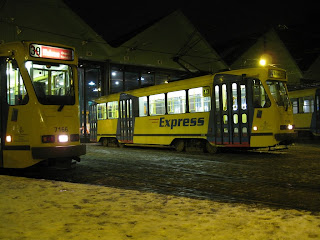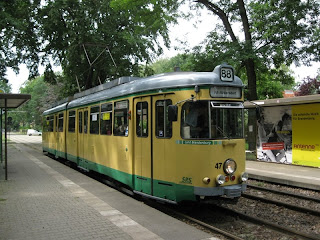The oldest (7008 of Jan 1952) and the youngest (7171 of July 1971) at a cold Tervuren on 12 Feb
Friday 12 February was the last day in service for the single car PCCs of STIB in Brussels. Investment in new rolling stock had seen the fleet dwindle to just 21 from a peak of 171, however a number had fallen by the wayside in the final months such that only eight were available for the 21 workings on the final day - the remainder used two section articulated PCC derivatives including the prototype car 7500 - due to continue in use until the summer and the double ended 77xx and 78xx series cars. A ninth car - 7036 - appeared as a duplicate to the last journey. The service cars were:
7008 - duty 405 from Ixelles depot 0521 Flagey-0136 Flagey
7156 - duty 727 from Woluwe 0652 -0954 and duty 736 1406 -1832
7158 - duty 728 from Woluwe 0653 - 1847
7161 - duty 409 from Ixelles depot 1107 Flagey-0117 Flagey (this may have worked duty 407 in the morning peak)
7166 - duty 733 from Woluwe 1118-1823 (this may have worked another morning peak duty)
7168 - duty 722 from Woluwe 0607-0113 Flagey
7169 - duty 725 from Woluwe 0642-0944 and duty 738 1536 - 1835
7171 - duty 726 from Woluwe 0647-1835
This was a well thought out allocation is it meant:
7008 - the oldest car was the first into service (0521 service 81 from Flagey) and the operated the last journey (Service 39 0106 Ban Eik to Montgomery then 0126 81 to Flagey) and was the last to serve the underground terminus at Montgomery departing at 0031.
7008's penultimate round trip - the 44 2318 Montgomery to Tervuren packed with enthusiasts
7161 - the only car of the 1971 batch to retain its original frontal appearance with large headlamp provided the last departure from Tervuren
7169 and 7171 - both returned to depot at 1835 where they were handed over to the tram museum for preservation in a ceremony - with the museum's 7065, sister cars 7156, 7166 and (at the end) 7158 also in the depot yard for photos.
7169 stands in front of its new home at the Musee du Tram with sister car 7171 behind in the depot during the hand over ceremony.
7169 was the last to leave the depot on a scheduled service route - the 1536 service 44 to Tervuren 7158 was the last to return to Woluwe at 1847 - the depot routinely closes after the last evening run in car arrives c2015.
7169 leaves Woluwe Depot to as the last PCC to enter service for the afternoon peak - 1536 44 to Tervuren.
7158 was the last service car to return to Woluwe (three more remained in use after the depot closed for the night)
The withdrawn PCCs are moving to storage at Haren depot. 7008 - its duplicate 7036, 7161 and 7168 went straight to Haren from Flagey - the normal terminus for depot workings from Montgomery. Photographs on line show 7021, 7022, 7156, 7160, 7164, 7165, 7166 and 7170 at least also there. What the future holds for these cars is unknown.
Preserved 7065 has recently been repainted in its late 1980s/early 1990s version of the fleet livery and was displayed outside the museum before and during the hand-over ceremony for 7169 and 7171. The museum also has 7016 which was inside the depot, 7047 under major overhaul and 7093 currently under repaint.
7156 and 7166 stand outside the museum awaiting transfer to Haren depot for storage
7171's last working was the 1819 39 from Ban Eik to Woluwe and it was reversed into the museum running shed for handover to MTUB
Tervuren terminus has for many years been associated with the PCC - future appearances will be by the museum's preserved fleet. Here 7166 leaves for Montgomery.














































